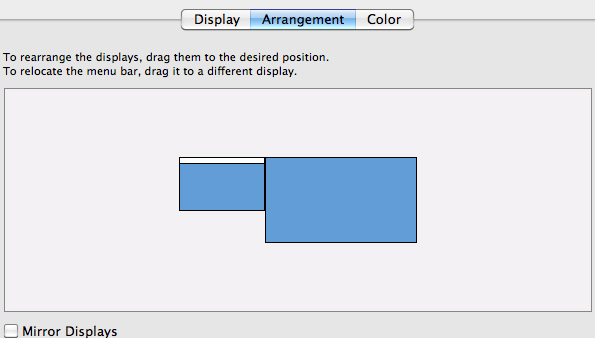Promise Pegasus R6 & Mac Thunderbolt Review
by Anand Lal Shimpi on July 8, 2011 2:01 AM ESTDisplayPort Passthrough
The Pegasus has two Thunderbolt ports. You can use the second port to daisy chain up to six Pegasus devices together, for up to 36 drives. With a single Pegasus in its default configuration able to hit over 5Gbps, you'd definitely run into bandwidth limitations with six of these things. But you could get by with two and not be limited by Thunderbolt.
There's another role that second Thunderbolt port can play: as a DisplayPort output. Remember both PCIe and DisplayPort are carried on a single Thunderbolt cable, the latter occupying half of the 40Gbps of total bandwidth available.
At the end of a Thunderbolt chain you can insert a miniDP display, currently the only option is the 27-inch LED Cinema Display but in theory other panels that accept a miniDP input could work as well.
I connected a 27-inch Cinema Display through the Pegasus without any problems. The Pegasus does have to be on for you to get video however, so if you ever have to shut down the Pegasus you do lose video to the Cinema Display.

Audio still works, so you'll see the Cinema Display as an audio device on your Mac:

The experience is pretty seamless overall.
I ran a quick test to see if I lost any bandwidth to the Pegasus with the 27-inch Cinema Display in the chain. I measured a slight performance drop (< 3%) in the best case scenario of four SF-2281 SSDs in a RAID-0 array on the Pegasus, but nothing substantial at all. Note that simply displaying an image at 60Hz on the 27-inch Cinema Display requires over 6.75Gbps of bandwidth (because of 8b/10b encoding), so a full Thunderbolt channel is necessary for DisplayPort (although admittedly it only needs to be unidirectional bandwidth).
| Thunderbolt PCIe + DP Bandwidth Test | ||||
| 2MB Sequential Write, QD16 | No DisplayPort Passthrough | 27-inch Cinema Display Connected | ||
| Promise Pegasus R6 (4 x SF-2281 SSDs, RAID-0) | 1002.7 MB/s | 988.2 MB/s | ||










88 Comments
View All Comments
Conner_36 - Friday, July 8, 2011 - link
Or even in the office, to able to take your entire project and move between the rooms carrying ALL of the data? That's unheard of!From what I understand with HD movie editing I/O is the bottleneck.
All we need now is an SVN hardware device with thunderbolt to sync across multiple thunderbolt RAIDs. Once thats out you could have a production studio with some real mobile capabilities.
Exodite - Friday, July 8, 2011 - link
I wager pretty much any usage scenario can come up with a high-performance 12TB storage solution for significantly less than 2000 USD.You're right though, it's definitely not the solution for me.
Or anyone I know, or am likely to ever know. *shrug*
Zandros - Friday, July 8, 2011 - link
What happens if you try the Macbook Pro -> Pegasus -> iMac in Target Display Mode -> Cinema Display connection chain?Focher - Saturday, July 9, 2011 - link
Pretty sure the DP monitor has to be the last device in the chain. Maybe that is just a current limitation because there are no Thunderbolt displays.Zandros - Monday, July 11, 2011 - link
AFAICT, the iMac is a Thunderbolt display, since it does not support Target Display Mode from Display Port sources with Display Port cables.tipoo - Friday, July 8, 2011 - link
Is there a way to make it shut off the drives after idling for a while?piroroadkill - Friday, July 8, 2011 - link
But when you saw the file creation maxed out at 9TB, on 10TB array..Since.. uh, Snow Leopard, Apple changed file and drive sizes to display decimal bytes as used by the manufacturers, which is the same as the 10TB array.
However every other thing ever reports in binary bytes, such as windows describing "gigabytes" even though it means gibibytes in reality.
Ugh, anyway, what I'm trying to get at is that maybe you did infact fill the array. That said, the thing shouldn't have fucked up..
CharonPDX - Friday, July 8, 2011 - link
If I had way too much money, my usage model for Target Display Mode would be to use the iMac as a Virtual Machine host/server, connected to either a second iMac or a MacBook Pro as a dual-screen workstation.With the minimum 27" iMac, you're basically buying a 27" Cinema Display plus a $700 Mac mini-on-steroids. If you want a second Apple display for your iMac or MacBook Pro, and want a Mac Mini to use as a server, that is an excellent value to instead just get a second iMac. (That value may drop depending on the next Mac Mini update, of course.)
etamin - Friday, July 8, 2011 - link
in the block diagram on the first page, why is the Thunderbolt Controller connected to the PCH thru PCIe rather than to the processor? I thought PCIe connections came off the processor/NB?repoman27 - Sunday, July 10, 2011 - link
The lanes that come off the processor/NB are usually used for dGPU. On the new MacBook Pros, Apple borrowed four of them for the Thunderbolt controller. Apparently on the new iMacs, however, they decided to give all 16 lanes from the CPU to the graphics card and pulled four from the PCH instead.